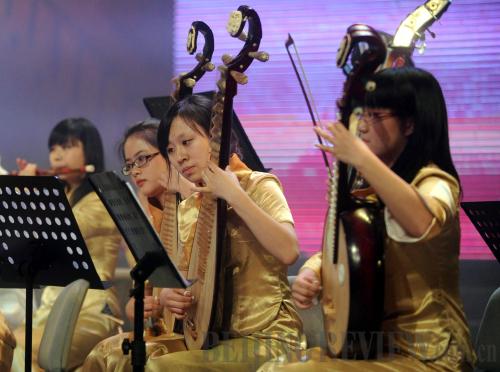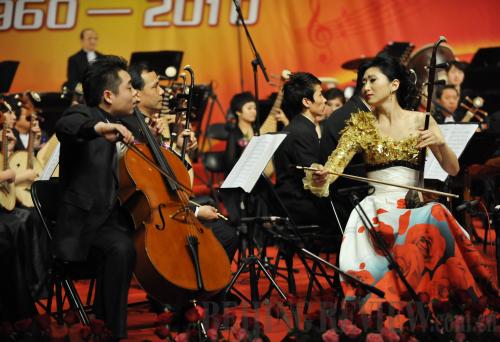|
Booming spin-offs
 |
|
STANDARD: Students from the China University of Political Science and Law play Chinese folk music in Beijing on December 8, 2010 (XINHUA) |
The popularity of folk music has greatly promoted the development of the manufacture of musical instruments. In 1978, there were approximately100 folk musical instrument manufacturers nationwide and they were mainly located in big coastal cities. The number now has increased to 2,000, and manufacturers are distributed all over the country. The industry has also developed from family workshops where instruments were pieced together by hand to a large industrial chain stretching from raw material and production to sales to after-sale service.
Statistics from the Guangzhou-based Private Economy News show the gross output of China's folk musical instrument industry reached 902 million yuan ($137 million) in 2007. It has increased 45 times during the last 30 years. Export earnings accounted for 30 percent.
"Chinese folk music develops so fast overseas, especially in East Asia and Southeast Asia. The two big markets, domestic and international, have attracted large amounts of investment from the private sector and foreign capital to folk musical instrument manufacture. The industry has now entered a mass market period," said Feng Yuankai, Director of the Information Division of the China Musical Instrument Association.
Ten years ago, the annual output of Shanghai No.1 National Musical Instruments Factory was only 2 million pieces, but has now increased to 10 million, of which 30 percent is for export. The factory has also built an exhibition hall for Chinese folk music instruments and holds competitions regularly.
Pressing task
Will a greater number of people become fans of the genre? This is a question the artists are always pondering. "The key thing is how we get folk music out there. People don't care about the pattern. As long as it is close to their lives, they will love it. The beauty of folk musical melody cannot be lost, but it is very possible to mix dynamic and modern performance features into this traditional art to create wonders," Zhou Wei with the China Oriental Performing Arts Group said.
 |
|
INNOVATION: Famous folk artists, erhu player Yu Hongmei and cellist Wang Chongwu, play together with the Chinese National Orchestra on November 4, 2010, to celebrate the orchestra's 50th anniversary (XINHUA) |
At present, though there is rapidly growing enthusiasm for folk music, the works to impress listeners the most are still the traditional pieces such as Jubilant, Moon and Flower in the Spring River and The Moon over a Fountain, all composed decades ago.
Li Guanghua, head of the Folk Music Department of the Central Conservatory of Music said, "Lack of new works is a serious barrier to the development of the music. The fundamental reason is many composers regard folk music creation as just a task. They may write some works for only one performance in a period." Many excellent works were created during the composers' school days, such as The Butterfly Lovers. And many managers of orchestras always restrict their vision to famous composers, but the composers often have several tasks at the same time, and don't have enough energy to create better works, said Li.
"Now the creative atmosphere in our conservatory is very good," Li said. "The performing ability of students is improving. Every year, we will go out to look for creative inspiration. Teachers encourage students to create new works. Whenever someone has a good idea, they will be given a chance of brainstorming."
Xi Qiang, President of CNO, said the CNO had begun an internal reform and was aiming for innovation. "We have adapted some pieces of pop music, such as Jay Chou's famous Juhuatai, which is suitable for adaptation and performed as folk music. When we perform them in schools and universities, the audiences scream a lot. You see how much they love them. If we want to attract the audiences' attention, we must set up an exchange platform. Mixing pop music with folk music will let them taste the elegance of folk music through familiar melodies." |
